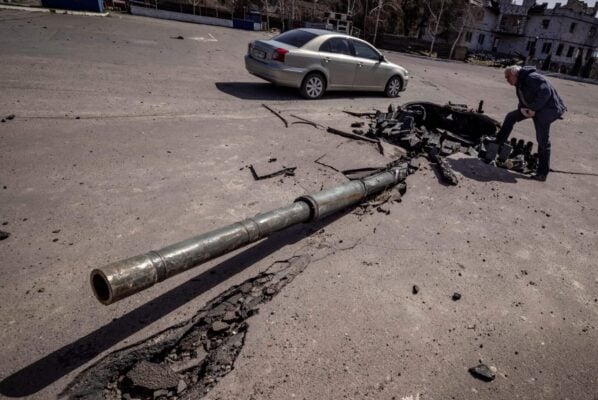
A Turret, likely from a T-72, is embedding into the ground after being ejected from the hull of the tank after a catastrophic explosion.
While the impression most have of a Tank is of a shield of almost invincible armour that can push through any obstacle while under fire to reach their objective, these designs in warfare are more complex than these basic assumptions. Tanks as a concept were built as a strategic assets on the battlefield, and while in some cases they did have that Iron Man quality to them, even the first tanks were often damaged, mauled and burned in large numbers in the most horrific of ways.
Recently, the loss of upwards of four American M1 Abrams Tanks in Ukraine has followed the loss of other important assets like a NASAMS system, CAESAR and a HIMARS. None of these assets operated in a bubble, and the larger concern of progress for Ukrainian forces must account for losses of equipment in concert with the strategic gains/failures in losing these assets. Earlier losses of German made Leopard 2s after the initial start of the summer offensive in 2023 also raised concerns as they have with recent losses of Abrams. With additional and persistent losses of American Bradley Fighting Vehicles, the high morale of having Western equipment dominating the field of battle should have never presumed that any loss of valuable assets as a complete loss via binary measures in such conflicts.
Regarding the survivability of Western Tanks like the Leopard 2 and M1 Abrams vs. those ex-Soviet and Russian tanks, the massive losses of armour in the first year of the war in Ukraine by Russian forces and many losses of similar equipment by Ukrainian forces produced a narrative that ex-Soviet armour was poor equipment, and that such systems would be easily dispatched by Western tanks. Strategic mistakes by Russia in the early stages of the war mirrored those of past losses of Leopard 2s, as without infantry support most tanks would be unable to survive on their own, and could be disabled by two Bradleys or a group of determined fighters with RPGs. Even with modern equipment, disabling a modern tank that has no support is very possible, and tanks must never be used as an independent asset on the battlefield.
With modern advances in reconnaissance via optics, drone and satellite technology, tanks have a difficult time being elusive on the battlefield. Artillery systems, even ones upwards of fifty years old, can damage or destroy a modern tank if they receive correct and rapid targeting information from their support teams. Few tanks can stand up to a standard Soviet era 152mm shell if hit directly, and almost all tanks will be disabled by the blast and shrapnel effects of near hits from such shells. Shells have become one of the most important commodities in the field, and old stocks of North Korean and Chinese shells can be very effective, even if they are of a dated design and have been stored for a generation. This is the reason Russia has pursued purchasing old shells from China and North Korea, as they are still a key asset in this conflict.
Modern tanks have their advantage over older models in a few crucial areas. They are designed to be able to see their target first, and fire first, as in many cases the first to fire is the tank that survives. They are also coordinated digitally with the larger tank force and other assets to perform their strategic goals in a more rapid and organised fashion. An attribute that does stand out with later generations of tanks on both sides of the conflict is not producing an invincible tank, but one that can fire as many times as possible in reaching the objective while enabling the crew to survive their tank being disabled, or even destroyed. Systems such as cage and layered armour, ERA, sensor scrambling lasers, and explosive countermeasures exist on many modern tanks, and exist on both sides of the conflict. Crew survivability is very important to the side that has less soldiers on the battlefield, and perhaps is somewhat neglected by those armour forces that have a clear numerical advantages in the number of crews and tanks. For Ukraine, it is more important to save the crews of the tanks so they can fight in a new tank later on. For Russia, later variants like the T-90M focus on optics and survivability, with older Soviet era variants becoming famous for ejecting their turrets when the hull is breached. Tanks were never invincible, but crews of Ukraine’s Leopard 2s and M1 Abrams might survive to fight in future battles, if a new tank is available.